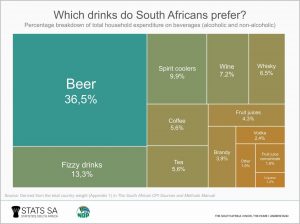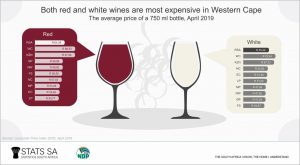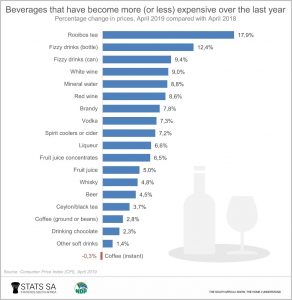Pondering #NationalWineDay
25 May is National Wine Day! Here are a few fun facts to muse over if you’re planning to enjoy a glass or three.
SA households spend more on wine than on coffee
South Africans have clear priorities when it comes to drink. Wine takes up 7,2% of total household expenditure on alcoholic and non-alcoholic beverages, according to Stats SA’s inflation basket. This places wine in fourth place as the most popular beverage that households spend money on.
Beer is the clear winner, taking up over a third of household spending on beverages, followed by fizzy drinks and spirit coolers. Whisky follows wine in fifth place (click on the image to enlarge).
Coffee,1 the darling of beverage-related internet memes, is tie with tea, taking up 5,6% of household spending on drinks. That’s in sixth place. Siestog.
Wine’s 7,2% can be further broken down into red (3,9%) and white (3,2%). As a nation, it seems we are slightly more partial to red wine over white.2
Wait for it … wine is the most expensive in Western Cape
Maybe it’s not that much of a surprise, as Western Cape is the hub of the wine industry in South Africa. The most recent data show that the average price of a 750 ml bottle of red wine will set you back R88,50 in that province, higher than the national average of R64,38.3
If you’re feeling a little contrarian to the popularity of red wine and choose to drink the alternative, Western Cape is also the most expensive in terms of white wine (R70,44 for a bottle). KwaZulu-Natal is the second most expensive province for both red and white varieties.
Wine is notably cheaper in other provinces. As you work down the price lists above, you can’t help wondering whether other provinces prefer the “cardboardeaux” over the bottled variety. But we’re not judging…
Wine prices have risen over the last year, but not as quickly as rooibos
Inflation data show that red and white wine prices have risen over the last 12 months, but not as much as fizzy drinks and rooibos tea. You are paying, on average, 8,6% more for a bottle of red wine than you did a year ago. White wine prices have risen by 9,0%.4
Rooibos drinkers in particular have had a rough time, with prices for the tea jumping by 17,9% in the twelve months to April. The rooibos industry is currently recovering from a four-year drought that has constrained supply, contributing to the rise in prices.5
Wine prices have risen faster than the prices of other alcoholic beverages such as brandy, vodka, whisky and beer.
At the end of the day, the price may be a secondary consideration if you’re a fan of wine. National Wine Day presents an opportunity for you to join all other wine fanciers to celebrate this culturally important drink. Enjoy responsibly!
1 Includes ground coffee, coffee beans, and instant coffee.
2 These figures are derived from the total country weight figures in Appendix 1 in Stats SA’s South African CPI Sources and Methods Manual (available here). For example, the weight for beer in Appendix 1 is 2,14% of total household expenditure. This represents 36,5% of the total weight of all non-alcoholic and alcoholic beverages.
3 Note that this is an average of prices collected across the entire range of wine products. Every month price collectors from Stats SA visit retail outlets around the country to record thousands of prices for items ranging from food to clothing and household appliances. The data are used to compile Stats SA’s monthly consumer price indices.
4 Stats SA, CPI (5 and 8 digit) from Jan 2017 (201904), Excel file (available here).
5 702, Why rooibos tea price remains high despite improved rains (read here).





